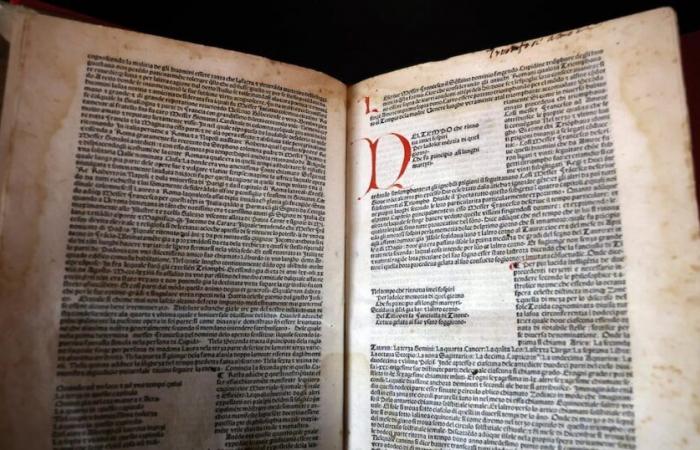
With more than 540 years old, “Petrarca triumphs” is one of the oldest books in the world and is part of the Neruda collection of the Andrés Bello central Archive. Printed in 1484 in Venice, this incunable protects on the evolution of the book, its design, its reading and circulation. Its conservation allows not only its material rarity, but also the patrimonial role of the University of Chile.
Every April 23 the International Book daya date destined to promote reading and its relevance in our society. A legacy that covers millennia since the beginning of writing and centuries from the emergence of the first presses. Under that perspective, among the thousands of books that protect the Andrés Bello Central Archivepatrimonial nucleus of the University of Chileis a copy that is located within the first books printed in the world.
A story that begins when Johannes Gutenberg He developed an invention that revolutionized the history of humanity. The transformation in the material production forms of this precious object, through a system based on the creation of metal mobile types for each letter of the alphabet, allowed massive reproduction, faster and lower text cost, and promoted literacy and the dissemination of knowledge, changing forever the way in which ideas and representations are transmitted.
The first texts that occurred under this technique between 1440 and 1500 were called “Incunable”, which means place of birth or beginning (of “cradle”). At present these specimens are very valuable and a jewel in each collection, because they allow us to understand and analyze the evolution of the book as material support. It should be noted that there are two types of incunable, Europeans and Americans, the latter correspond to the first specimens produced in Latin America between the sixteenth and seventeenth centuries, with the first printers that worked in the continent
Among the wonders that the central archive Andrés Bello is protected are two incunable Europeans. The oldest of these corresponds to Petrarca triumphsa book printed in 1484 in the city of Venice in Italy. A text that became part of the collections of the University of Chile through the Delivery Pablo Neruda made of his private library in 1954.
To Gabriel González, Coordinator of the Cultural Management and Extension Area of the Andrés Bello Central Archive “It is a surviving copy, by printing in the first printing press of the world, particularly in Venice, in the midst of a social political conflict that was of a large scale such as the salt war and that circulated through various hands that guarded him and made him survive to this day.”
This unfinished work of the Italian poet and philosopher Francesco Petrarca (who wrote in Latin and to a lesser extent in the vernacular language) has been one of his less studied works and talks about the Christian moral and spiritual connection, specifically of the Catholic faith. This edition of the fifteenth century is mediated by the scholarly comment of the scholar Bernardo Illicino, who covers these thirds with an explanatory encyclopedic knowledge and reflects on this work.
In detail, Gabriel González points out that this book is an example of how the incunables allow you to reflect on reading mediation processes unlike contemporary texts. “What we can see in Petrarca’s triumph Different, we have full clarity about the autonomous work of a poet, the texts and critical comments that can normally be observed through a prologue or epilogue ”.

It should also be noted that this copy was made before the arrival of the Aldine printing press in 1494 which is the one who gives the first modern layout to these books with spelling symbols that mark pauses and relationships in the text. “We see that this book has no points, eat or have some characters that may seem a bit strange, for example, the peculiarity of the ‘C’ that is carried out to encrypt the scholarly comment. With this we see the transition processes between the medieval enlightening and of the printing press itself.”
In the same way, in some pages of this incunable their striking red chapter letters, hand drawn without the use of the printing pressanother detail that shows the course of maturation in the printed plane, the diagramming and design of the books. “It is striking to see the book as a living object that develops in different aspects and that is mutating over time. Both in its impression and also in its reception”González commented.
This is how this specimen not only allows the Neruda collection to be valued National Historical Monument and part of the history of the University of Chile, but also allows us to reflect on the very history of the circulations of the book throughout its history.

Curiosities in the manufacture of this incunable
An important characteristic and difference with the modern books of Petrarca triumphs is present in the composition of its leaves. This specimen is manufactured with rag paper, a typical element of the time and is created by recycling cotton or linen clothing garments.
Loreto MillarCoordinator of the Patrimonial Conservation and Restoration of the Central Archive Andrés Bellohe points to us that “as the techniques of elaboration and creation of the books are evolving, allowing greater production, the paper is more scarce. Then, the papermus teachers are looking for different raw materials to create this element. In this case, after trying with cotton or with other vegetable fibers in Europe one of the resources that had the greatest presence were the remains of clothing rags.”
Another detail that allows to differentiate this incunable from the current books is in the use of metalloacid ink of the specimens of that time and that was composed of acids, of tannins that come from trees and some binders. “In the case of the parts that are handwritten, it is perceived by the type of brand that remained in the paper that would be ferrogal ink. An ink that tends to have brownish colors and dark because it degrades very easily,” says Millar.
Finally, with respect to the binding cover, Loreto Millar explains that “At that time it was very common for the bindings to be made in parchment performed on non -nathas. However, the binding that can be seen in this incunable book is half -pasta with a piece overlapping with the name of the book recorded with gold, so it could be elucidated that it was made after the acquisition of the specimen ”.





